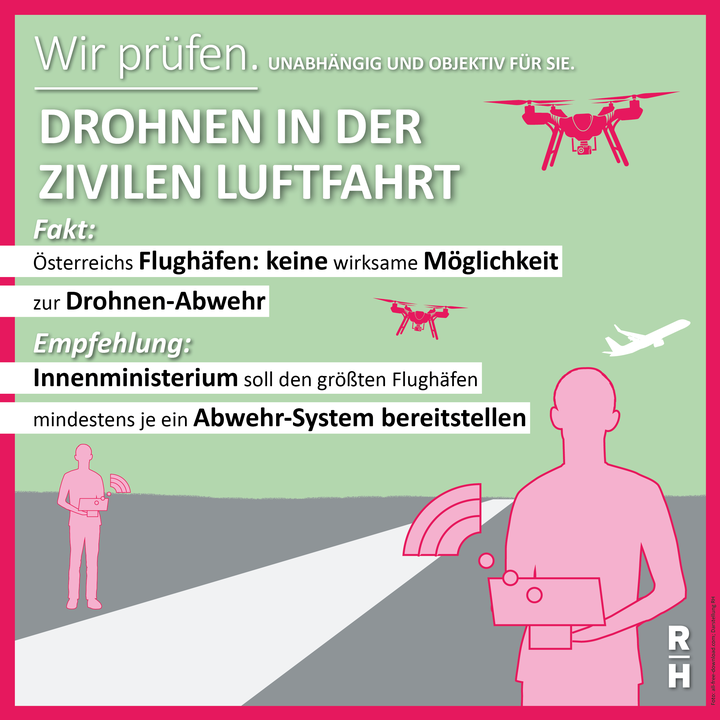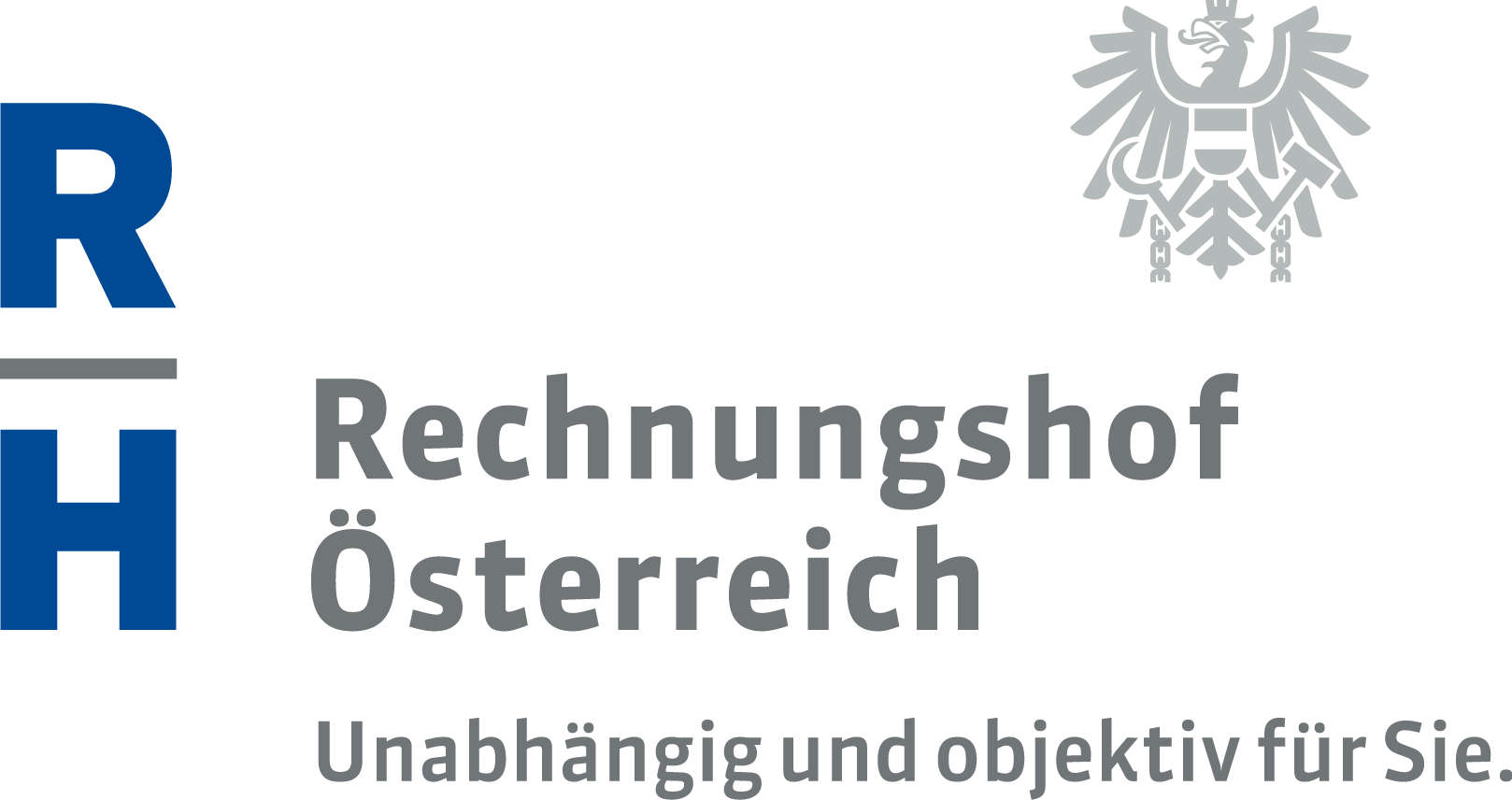ACA presents two reports on drones

Today, the Austrian Court of Audit (ACA) presented the following reports:
- Drones in Civil Aviation (in German)
- Procurement and Use of Drones at the Austrian Armed Forces (in German)
No effective means of defence against drones at airports
The ACA carried out an audit of how authorities deal with drones in civil aviation. Neither the Austrian air navigation service provider Austro Control nor the airports in Austria have stationary counter-drone systems. Furthermore, only about seven per cent of the drones requiring an operational approval were authorized. And: private individuals have only limited means to take action if they feel disturbed by drones. This has been revealed by the ACA in its report “Drones in Civil Aviation” published today.
Increased danger at airports due to drones
Austria’s airports have no effective means of defence against drones. In the audited period of 2013 to 2017, the airports could only resort to counter-drone devices of the Federal Ministry of the Interior in the case of an emergency. They, however, had to be transported to the airport first. Consequently, they would have been deployable only with a delay.
Airports are particularly at risk since aircrafts move below 150 metres during take-off and landing. This is the maximum flight altitude allowed for drones. Aircrafts can be forced to undertake flight manoeuvres, for example to prevent a collision with a drone.
Due to the substantial risk of causing injury to persons and damage to property, the ACA recommends to the Federal Ministry of the Interior to make available at least one counter-drone system for the largest airports on site. In this way, a quick response could be ensured in the case of an emergency. Furthermore, counter-drone strategies should be developed for airports. Internationally, such tests are already carried out: the deployment of birds of prey, net guns and laser cannons is for example being tested. At the time of the audit, two research projects were carried out in Austria that dealt with safety aspects with regard to drones.
Furthermore, the ACA recommends to the Federal Ministry of Transport, Innovation and Technology, the Federal Ministry of the Interior and to Austro Control to pool the findings emerging therefrom and to step up their cooperation.
No special permit for Austria’s special operations tactical unit
Austro Control is currently responsible for the operational approval of the drone types “remotely piloted aircraft systems class 1” (“Luftfahrzeuge der Klasse 1”) and “remotely piloted aircraft systems class 2” (“Luftfahrzeuge der Klasse 2”). From 2014 to 2018 it issued 6,751 operational approvals. It assumed that considerably more drones are operated without the required approval in Austria.
The operation times approved by Austro Control for drones generally ran from Monday to Friday from 8 a.m. to 6 p.m. as well as on Saturday from 8 a.m. to 2 p.m. Furthermore, Austro Control approved drone flights only above unpopulated areas with a distance of 150 metres to settlements. Also for the Cobra, Austria’s special operations tactical unit, Austro Control first refused to make an exception. The Cobra had requested an operational approval for surveillance and operational flights in densely populated or at least populated areas. Negotiations with regard to realistic approval parameters lasted from February 2018 until the ACA’s on-site audit in October 2018. Eventually Austro Control permitted the Cobra to operate drones for a limited time during dawn and dusk and only for one year.
The ACA critically notes that although the Cobra had had drones at its disposal for special tasks for eight months, it could only use them in a very limited manner due to the delayed approval procedure. Specific intervention organizations to be determined should be exempted from this approval procedures.
Only seven per cent of the drones are approved
According to the Austrian Economic Chamber, some 52,000 drones were sold in the period of 2015 to 2017. Toy drones and professional drones are not included. From 2014 to 2017, Austro Control issued 3,890 approval notices, which means that only about 7 per cent of the drone users fulfilled their obligation to obtain an approval. This low approval rate is perceived as problematic by the ACA.
In addition to the already described risks, the auditors revealed that private individuals have only limited means to take action if they feel disturbed by drones. If, for example, photographs or videos are made with a drone, there is the possibility to file a complaint at the Austrian Data Protection Authority. However, violations can only be sanctioned if indications can be given on the drone users. For the members of the Austrian Data Protection Authority it is virtually impossible to be on site in order to detect any violations immediately. The ACA recommends to amend the Data Protection Act in order to ensure that the police can intervene in cases of violations against data protection.
As of 1 July 2020, an implementing regulation of the European Commission will enter into force, which stipulates that drones must allow for an easier identification, for example through in-built chips that can also prevent the drone from flying above prohibitive zones.
- pdf Datei:
- 2,703.7 KB
- Umfang:
- 86 Seiten
Report: Drones in Civil Aviation (in German)
Drones at the Austrian Armed Forces: EUR 18,200 per flight hour, unclear possibilities of use
In its report “Procurement and Use of Drones at the Austrian Armed Forces” published today, the ACA criticises the lack of an overall calculation of the procurement and use of drones, the high costs per flight hour and the difficulties with regard to the deployment of drones. The ACA also noted the lack of an overarching, strategic concept. The audited period spanned the years from 2011 through 2018.
Expensive flights
The Federal Ministry of Defence budgeted EUR 3.28 million for the procurement of six drone systems “Tracker” of a French producer, but failed to budget additional expenses, such as those incurred for maintenance. Furthermore, a documentation of the overall costs was lacking. The ACA calculated the overall costs and critically noted that the costs amounted to EUR 4.42 million, thereby exceeding the expenditure budgeted by the ministry by 35 per cent. In the period of 2015 to 2018, the six drone systems reached only 243 flight hours, which resulted in EUR 18,200 per flight hour per drone. The ACA therefore recommends to take budgetary precautions, to traceably and fully document the overall costs and to use the purchased drone systems in an adequate way.
Problems with the deployment of drones
Bad weather conditions, such as rain and snow, caused massive problems with the deployment of drones. No sufficient surveillance was possible when there was rain and snowfall. Furthermore, bad weather resulted in a grounding of the drones and great cold even created the hazard of icing. Also the “dual use” technology envisaged by the armed forces, i.e. the use of drones for military, but also for civil purposes, did not work. Experiences during security policy assistance operations showed that the deployment of drones in the event of disasters was ineffective. Moreover, as regards border surveillance, the employment of drones was possible only to a limited extent. The ACA recommends to take into account the experiences made when preparing new performance specifications in the case of another procurement of drones.
Lack of a strategic concept
In the framework of its audit, the ACA found that the ministry had failed to devise a strategic concept. Staff-related, material and financial impacts of the introduction of drone systems remained unconsidered. In January 2019, for example, only six trained employees could carry out drone flights. Consequently, only three of the six drone systems could be operated simultaneously. Furthermore, the performance of 243 flight hours equalled an overall use of only some 10 per cent. A central recommendation of the ACA is therefore to prepare a comprehensive, strategic concept prior to the introduction of a new system.
- pdf Datei:
- 1,519.7 KB
- Umfang:
- 64 Seiten


